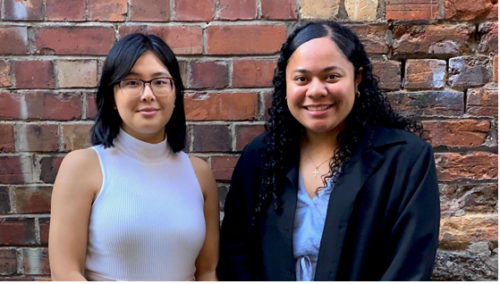
Two Auckland University of Technology (AUT) Faculty of Design and Creative Technologies students – Whitford’s Gayle Lee and Mt Wellington’s Jessica Vea – have been chosen as one of six finalists in the Global Lexus Design Awards competition.
Their concept Heartfelt, showcases creativity, innovation, empathy, and design skills that were adapted to a Covid-19 world and developed as part of the local Lexus New Zealand design awards, run in conjunction with AUT’s Faculty of Design and Creative Technologies.
As finalists, Jessica and Gayle will receive US$25,000 ($34,803) to complete their prototype for Heartfelt and participate virtually in a workshop with one-on-one mentoring from world class design professionals.
The Lexus Design Award competition works with a world-class panel of influential judges and the young Kiwi women behind Heartfelt have been chosen – along with five others – from more than 2000 international entries from 66 countries to compete for the Grand Prix trophy in April.
There was also a second Kiwi entry that got through by Henry Glogau, who has dual New Zealand and Austrian citizenship and currently resides in Denmark. His entry, Solar Destination Skylight, is a device that uses seawater to create natural diffused light, drinking water and leftover salt for energy creation.
Andrew Davis, Lexus New Zealand general manager, recognises that having three Kiwi designers in the global top six is a huge achievement – as well as for aspiring, young Kiwi designers across the country.
“Not only does the presence of clever Kiwi design at the International Lexus Design Award competition inspire up-and-coming talent – it works to raise the profile of New Zealand designers in a competitive market,” he says.
“Across all the finalists you can see an urgency to the problems being addressed by the designers, with a huge focus on humanity in relation to the changing climate and global pandemic.”
NZ-born Gayle grew up in east Auckland and attended Our Lady Star of the Sea in Howick and Sancta Maria College. “I am now AUT, where I am pursuing my Masters in Creative Technologies. I’ve gravitated towards design as I’ve always been curious about how things worked and how they could be improved. I used to do Hard Materials throughout high school and really enjoyed it so that was a factor as well.
She and Jessica became friends at University as they are doing the same degree. “Through our various projects, we found we worked well together and so teamed up to create ‘Heartfelt’,” said Gayle.
“Due to Covid-19, we were unable to go ahead with our original AUT project plans in semester one, so we decided to revise our project to be more Covid-related. Our new idea came about when a family friend passed away and the funeral had to be live-streamed.
“We couldn’t hug at the time and we really missed those hugs – hugs are comforting and warm. We thought, is there a way we can replicate the comfort of a hug while being socially distanced?”
Firstly, they broke down what a hug meant to them – warmth, presence and personal connection, and then based the functions of ‘Heartfelt’ off that.
It was just a happy accident that the heart shape was also comfortable to hold and was intuitive as people knew where to place their hands.
“It was simple and that’s what we wanted, especially if our target audience was the elderly,” said Gayle.
“Our device works in pairs, so as person one holds their device in their hands, person two’s device will warm to the temperature of person one. If not being held, the heart will drop to room temperature (neutral).
“There will also be lights that will pulse to reflect both you and your loved one’s heartbeat, imitating the effect of holding their hands where your breathing and heart rate will eventually sync.”










